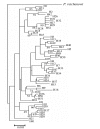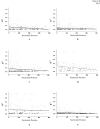Sequence diversity and natural selection at domain I of the apical membrane antigen 1 among Indian Plasmodium falciparum populations
- PMID: 18031585
- PMCID: PMC2211494
- DOI: 10.1186/1475-2875-6-154
Sequence diversity and natural selection at domain I of the apical membrane antigen 1 among Indian Plasmodium falciparum populations
Abstract
Background: The Plasmodium falciparum apical membrane antigen 1 (AMA1) is a leading malaria vaccine candidate antigen. The complete AMA1 protein is comprised of three domains where domain I exhibits high sequence polymorphism and is thus named as the hyper-variable region (HVR). The present study describes the extent of genetic polymorphism and natural selection at domain I of the ama1 gene among Indian P. falciparum isolates.
Methods: The part of the ama1 gene covering domain I was PCR amplified and sequenced from 157 P. falciparum isolates collected from five different geographical regions of India. Statistical and phylogenetic analyses of the sequences were done using DnaSP ver. 4. 10. 9 and MEGA version 3.0 packages.
Results: A total of 57 AMA1 haplotypes were observed among 157 isolates sequenced. Forty-six of these 57 haplotypes are being reported here for the first time. The parasites collected from the high malaria transmission areas (Assam, Orissa, and Andaman and Nicobar Islands) showed more haplotypes (H) and nucleotide diversity pi as compared to low malaria transmission areas (Uttar Pradesh and Goa). The comparison of all five Indian P. falciparum subpopulations indicated moderate level of genetic differentiation and limited gene flow (Fixation index ranging from 0.048 to 0.13) between populations. The difference between rates of non-synonymous and synonymous mutations, Tajima's D and McDonald-Kreitman test statistics suggested that the diversity at domain I of the AMA1 antigen is due to positive natural selection. The minimum recombination events were also high indicating the possible role of recombination in generating AMA1 allelic diversity.
Conclusion: The level of genetic diversity and diversifying selection were higher in Assam, Orissa, and Andaman and Nicobar Islands populations as compared to Uttar Pradesh and Goa. The amounts of gene flow among these populations were moderate. The data reported here will be valuable for the development of AMA1-based malaria vaccine.
Figures



References
-
- Cowman AF, Baldi DL, Duraisingh M, Healer J, Mills KE, O'Donnell RA, Thompson J, Triglia T, Wickham ME, Crabb BS. Functional analysis of Plasmodium falciparum merozoite antigens: implications for erythrocyte invasion and vaccine development. Philos Trans R Soc Lond B Biol Sci. 2002;357:25–33. doi: 10.1098/rstb.2001.1010. - DOI - PMC - PubMed
-
- Kocken CH, Withers-Martinez C, Dubbeld MA, van der Wel A, Hackett F, Valderrama A, Blackman MJ, Thomas AW. High-level expression of the malaria blood-stage vaccine candidate Plasmodium falciparum apical membrane antigen 1 and induction of antibodies that inhibit erythrocyte invasion. Infect Immun. 2002;70:4471–4476. doi: 10.1128/IAI.70.8.4471-4476.2002. - DOI - PMC - PubMed
Publication types
MeSH terms
Substances
LinkOut - more resources
Full Text Sources
Research Materials
Miscellaneous

